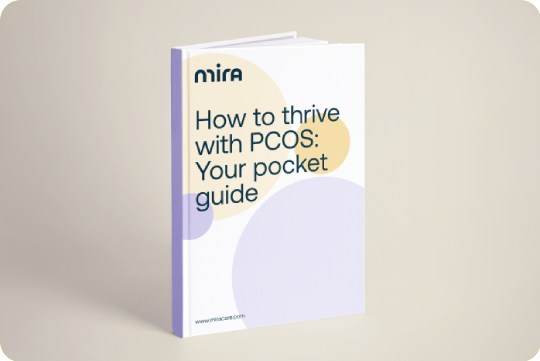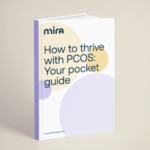The Difference of Endometriosis & PCOS + Can You Have Both?
An estimated 1 in 10 women are affected by endometriosis or PCOS at some point in their lives.
While each condition has its own distinct causes and symptoms, both conditions can potentially be painful, disrupt the menstrual cycle, and cause difficulties with getting pregnant.

In some cases, it is possible to have both conditions simultaneously – which can not only make life painful, but can also make you feel upset, confused, and isolated.
To help you navigate both PCOS and endometriosis, here is a look at the difference between the two, potential symptoms to expect, and treatment options available. We’ll also wrap up with some strategies to help you deal with your emotions if you are experiencing both PCOS and endometriosis at the same time.
Can you have both endometriosis and PCOS at the same time?
Yes. Although rare, it is possible to have endometriosis and polycystic ovary syndrome (PCOS) at the same time. Each condition on its own can negatively impact fertility, and studies suggest that having both at the same time can make fertility problems more severe.
Endometriosis vs PCOS
Because symptoms of endometriosis and PCOS may be similar, it can be a bit confusing to tell which one you may have. Here’s how they differ in terms of symptoms, causes, diagnoses, and impact on fertility.
What’s the difference between endometriosis and PCOS?
Endometriosis is a condition that causes abnormal tissue, similar to uterine lining, to grow around the pelvic organs. This in turn can cause severe pain during menstruation, intercourse, and throughout the menstrual cycle. PCOS on the other hand is a hormonal condition that affects the ovaries and can interfere with ovulation.
While the symptoms of both PCOS and endometriosis may overlap, the underlying causes and methods of treatment are much different. To help you better understand the difference between endometriosis and PCOS, here is a more in-depth look at each condition separately.
Endometriosis
Endometriosis is a painful condition in which tissue similar to the lining of the uterus (a.k.a. the endometrium) grows outside the uterus. This tissue most frequently grows on the uterine tubes and ovaries. However, it’s also possible to have extra-pelvic endometriosis — in fact, endometriosis has been found on every organ and anatomical structure in the body except the spleen.
Because the tissue builds up and bleeds in the same way that the endometrium does during your period, it can cause widespread inflammation in the body.
PCOS
Polycystic ovarian syndrome (PCOS) is a hormonal disorder primarily affecting women of reproductive age, though its effects can last beyond the reproductive years. Women with PCOS experience hormone imbalance and specifically make excess male sex hormones called androgens, as well as excess estrogen.
PCOS may also cause the ovaries to become enlarged and develop multiple cysts.
What are the main symptoms of endometriosis vs PCOS?
Symptoms of endometriosis and PCOS may overlap. Here’s a closer look at the distinct symptoms of each.
Endometriosis
Women with endometriosis may experience debilitating pain during their period, throughout their cycle, and/or while having sexual intercourse. Other women have no symptoms at all, yet can still have the disorder. The severity of symptoms does not correlate with the extent of the disease.
Other symptoms you might experience with endometriosis, besides pain, are:
- Heavy menstrual periods
- Infertility
- Bloating (sometimes called “endo belly”)
- Painful urination
- Painful bowel movements
- Constipation and/or diarrhea
- Rectal bleeding, especially during your period
- Nausea and/or vomiting, especially during your period
- Fatigue
PCOS
The hormonal imbalance caused by PCOS can lead to cysts growing on the ovaries (polycystic ovaries), irregular or missing periods, and high androgen levels.
Other common symptoms of PCOS include:
- Excessive body and facial hair
- Thinning hair and hair loss
- Acne
- Insulin resistance
- Fatigue
- Pelvic pain
Some women may have no symptoms, yet still experience the effects of PCOS, such as difficulties with getting pregnant.
What are the primary causes of endometriosis vs PCOS?
While the exact cause of endometriosis and PCOS is still uncertain, medical experts believe the following factors may play a role.
Endometriosis
According to the Office on Women’s Health, endometriosis may be caused by:
- Retrograde menstrual flow – for example, when uterine tissue released during your period flows through the uterine tubes.
- Genetics – endometriosis is known to run in families.
- Estrogen – high levels of estrogen may be a contributing factor for endometriosis.
- Immune system problems – a faulty immune system may fail to find and destroy endometrial tissue growing outside of the uterus. Immune system disorders and certain cancers are more common in women with endometriosis.
Other potential causes of endometriosis include surgical errors and coelomic metaplasia.
PCOS
For PCOS, the Office on Women’s Health names the following as potential causes:
- Heightened levels of male sex hormones – for example, testosterone, which can prevent ovulation and cause unwanted hair growth, acne, and male pattern baldness.
- Heightened levels of insulin – if your insulin levels are too high due to insulin resistance, this can cause the ovaries to produce more testosterone.
Other potential causes of PCOS include excess inflammation and genetics.
How are endometriosis and PCOS diagnosed?
Because symptoms of endometriosis and PCOS can be similar, doctors must look beyond the symptoms to determine whether you have endometriosis, PCOS, or both.
Endometriosis
Endometriosis can only be officially diagnosed via laparoscopic surgery, though your doctor may use imaging like an ultrasound and MRI to aid in the diagnosis. Laparoscopic surgery is a minimally invasive procedure where a doctor creates small incisions in your abdomen and uses a camera called a laparoscope to view your organs. If they find endometriosis, they can also use special tools to remove the lesions (called excision) and treat the disease.
PCOS
Your doctor can determine if you are experiencing symptoms of PCOS by using a blood test to check your hormone levels. They may also order an ultrasound to inspect your ovaries to see if they are polycystic.
How do endometriosis and PCOS impact fertility and TTC?
If you are trying to conceive (TTC), having endometriosis and PCOS may make getting pregnant naturally difficult. Here is how each condition may impact your fertility.
Endometriosis
An estimated 30-50% of women with endometriosis may have difficulties becoming pregnant. This is because endometriosis physically interferes with your reproductive organs, which may lead to any of the following:
- Tissue similar to uterine lining developing around the ovaries, uterine tubes, and pelvis
- Uterine tube scarring
- Pelvic inflammation
- Fluctuations in hormones and
- Weakened immune system functioning
Any of the above can cause disruptions with ovulation, fertilization, and implantation.
PCOS
Those with PCOS may also have difficulties with getting pregnant. This is because PCOS can cause a hormonal imbalance, which impacts your ability to ovulate naturally. Specifically, this includes your body’s ability to:
- Have a regular menstrual cycle
- Successfully release an egg
- Allow for implantation to occur
Without ovulation, pregnancy is not possible and working with your doctor to manage the cause of your hormonal imbalance is key to getting pregnant with PCOS.
What if you have PCOS and endometriosis together?
Although rare, it is possible to have both PCOS and endometriosis at the same time.
How common is it to have both?
Having PCOS and endometriosis at the same time is not considered common, although it does happen. For example, one study found that women with PCOS are considered at a greater risk of developing endometriosis. In another study, women with PCOS were more likely to have endometriosis compared to women without PCOS.
What does treatment look like?
There are a number of different treatments available for those with PCOS or endometriosis. Here is a closer look at some of the most common treatments.
Medication
Medication may be an option for some patients who are looking to get pregnant. Metformin is one medication used for PCOS and it may help you ovulate more regularly, allowing you to conceive naturally. Hormonal birth control is also used for symptom management in both PCOS and endometriosis, but it is not appropriate for women who are trying to conceive.
Laparoscopy
Laparoscopy is the gold standard of treatment for endometriosis. You should look for a skilled surgeon who specializes in excision (or cutting out endometriosis lesions), rather than ablation (or burning endometriosis lesions), as burning the lesions can cause scarring that may worsen infertility. An excision specialist will also make sure not to leave any endometriosis behind during surgery, as this can cause the endometriosis lesions to regrow and cause more pain.
It’s important to note that laparoscopy does not treat PCOS. If you have both conditions, you will need to treat your PCOS with medications, lifestyle changes, or other treatments suggested by your doctor in addition to having surgery for endometriosis.
Lifestyle Changes
Some women prefer a natural approach to managing endometriosis and/or PCOS. Maintaining a healthy lifestyle with a balanced PCOS diet and regular exercise routine can potentially boost your fertility. For PCOS in particular, gradual weight loss may help you regain your period and start ovulating regularly.
When it comes to endometriosis, you should look into adopting an anti-inflammatory diet rich in antioxidants. Many women with endo also experience relief of symptoms from going on a gluten-free diet (more on endometriosis diets here).
In-Vitro Fertilization (IVF)
In-vitro fertilization (IVF) may be an option for some women with endometriosis, PCOS, or both who are looking to get pregnant.
It is commonly used in cases where ovulation fails to happen with the use of oral agents, such as clomiphene citrate, Letrazole, and gonadotropins. During an IVF treatment, gonadotropin releasing hormones, such as agonists or antagonists with exogenous gonadotropins, are used to provide mature follicles with eggs. The eggs are then retrieved from the ovaries after an hCG injection, fertilized in a lab, and then transferred back to the uterus.
IVF is typically the third line of treatment for infertility in women with PCOS and endometriosis.
Managing Your Emotions if You Have Both Polycystic Ovarian Syndrome and Endometriosis
The emotional toll of being diagnosed with both PCOS and endometriosis can feel overwhelming. Many women talk about feeling angry, depressed, or hopeless about their diagnoses.
Both disorders can cause painful, uncomfortable, and embarrassing symptoms. Living with these symptoms, yet knowing there is no cure for them, can be frustrating and saddening. The following tips can help you manage the emotional toll of both PCOS and endometriosis:
- Find a support group. Whether online or in-person, meeting other women with the same disorder(s) may help you feel less alone.
- Choose a skilled and supportive doctor. The right medical professional will listen to your concerns, take you seriously, and be up-to-date on the latest research.
- Take things one day at a time. Some days you may need to rest more, while other days you may have more energy. Plan your daily activities around how you’re feeling as much as possible to avoid burnout and fatigue.
Be prepared to manage symptoms on-the-go. Keeping supportive items, such as heating patches or over-the-counter pain relievers, in your purse, work desk, or car can help you feel less overwhelmed by symptoms when you’re away from home.
Mira’s Editorial Process
All content produced by Mira meets stringent editorial standards, ensuring excellence and accuracy in language and medical precision. Every piece undergoes thorough fact-checking and review by qualified professionals. Check out our full editorial process to learn more.










